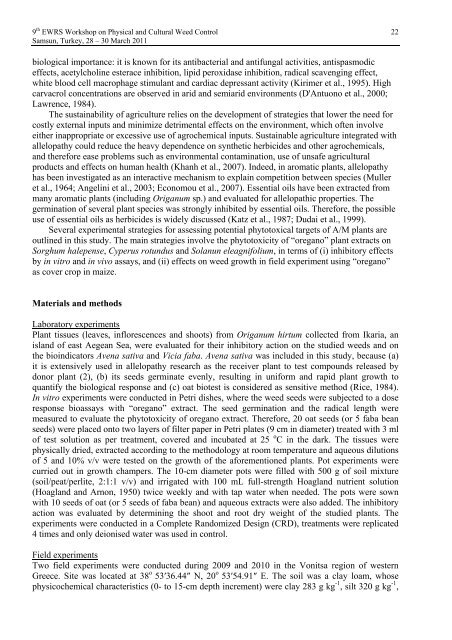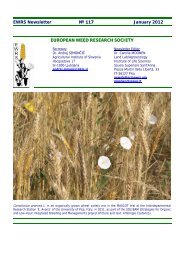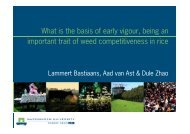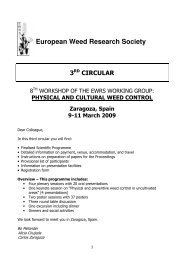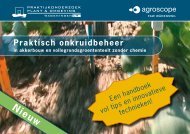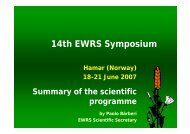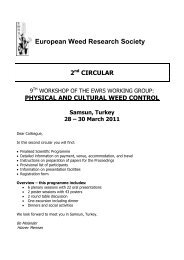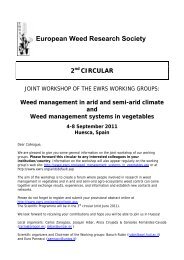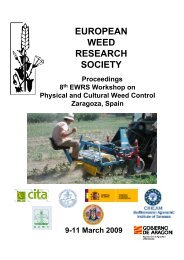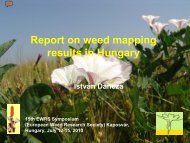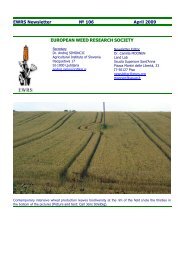Physical and Cultural Weed Control Working Group of - European ...
Physical and Cultural Weed Control Working Group of - European ...
Physical and Cultural Weed Control Working Group of - European ...
You also want an ePaper? Increase the reach of your titles
YUMPU automatically turns print PDFs into web optimized ePapers that Google loves.
9 th EWRS Workshop on <strong>Physical</strong> <strong>and</strong> <strong>Cultural</strong> <strong>Weed</strong> <strong>Control</strong> 22<br />
Samsun, Turkey, 28 – 30 March 2011<br />
biological importance: it is known for its antibacterial <strong>and</strong> antifungal activities, antispasmodic<br />
effects, acetylcholine esterace inhibition, lipid peroxidase inhibition, radical scavenging effect,<br />
white blood cell macrophage stimulant <strong>and</strong> cardiac depressant activity (Kirimer et al., 1995). High<br />
carvacrol concentrations are observed in arid <strong>and</strong> semiarid environments (D'Antuono et al., 2000;<br />
Lawrence, 1984).<br />
The sustainability <strong>of</strong> agriculture relies on the development <strong>of</strong> strategies that lower the need for<br />
costly external inputs <strong>and</strong> minimize detrimental effects on the environment, which <strong>of</strong>ten involve<br />
either inappropriate or excessive use <strong>of</strong> agrochemical inputs. Sustainable agriculture integrated with<br />
allelopathy could reduce the heavy dependence on synthetic herbicides <strong>and</strong> other agrochemicals,<br />
<strong>and</strong> therefore ease problems such as environmental contamination, use <strong>of</strong> unsafe agricultural<br />
products <strong>and</strong> effects on human health (Khanh et al., 2007). Indeed, in aromatic plants, allelopathy<br />
has been investigated as an interactive mechanism to explain competition between species (Muller<br />
et al., 1964; Angelini et al., 2003; Economou et al., 2007). Essential oils have been extracted from<br />
many aromatic plants (including Origanum sp.) <strong>and</strong> evaluated for allelopathic properties. The<br />
germination <strong>of</strong> several plant species was strongly inhibited by essential oils. Therefore, the possible<br />
use <strong>of</strong> essential oils as herbicides is widely discussed (Katz et al., 1987; Dudai et al., 1999).<br />
Several experimental strategies for assessing potential phytotoxical targets <strong>of</strong> A/M plants are<br />
outlined in this study. The main strategies involve the phytotoxicity <strong>of</strong> “oregano” plant extracts on<br />
Sorghum halepense, Cyperus rotundus <strong>and</strong> Solanun eleagnifolium, in terms <strong>of</strong> (i) inhibitory effects<br />
by in vitro <strong>and</strong> in vivo assays, <strong>and</strong> (ii) effects on weed growth in field experiment using “oregano”<br />
as cover crop in maize.<br />
Materials <strong>and</strong> methods<br />
Laboratory experiments<br />
Plant tissues (leaves, inflorescences <strong>and</strong> shoots) from Origanum hirtum collected from Ikaria, an<br />
isl<strong>and</strong> <strong>of</strong> east Aegean Sea, were evaluated for their inhibitory action on the studied weeds <strong>and</strong> on<br />
the bioindicators Avena sativa <strong>and</strong> Vicia faba. Avena sativa was included in this study, because (a)<br />
it is extensively used in allelopathy research as the receiver plant to test compounds released by<br />
donor plant (2), (b) its seeds germinate evenly, resulting in uniform <strong>and</strong> rapid plant growth to<br />
quantify the biological response <strong>and</strong> (c) oat biotest is considered as sensitive method (Rice, 1984).<br />
In vitro experiments were conducted in Petri dishes, where the weed seeds were subjected to a dose<br />
response bioassays with “oregano” extract. The seed germination <strong>and</strong> the radical length were<br />
measured to evaluate the phytotoxicity <strong>of</strong> oregano extract. Therefore, 20 oat seeds (or 5 faba bean<br />
seeds) were placed onto two layers <strong>of</strong> filter paper in Petri plates (9 cm in diameter) treated with 3 ml<br />
<strong>of</strong> test solution as per treatment, covered <strong>and</strong> incubated at 25 o C in the dark. The tissues were<br />
physically dried, extracted according to the methodology at room temperature <strong>and</strong> aqueous dilutions<br />
<strong>of</strong> 5 <strong>and</strong> 10% v/v were tested on the growth <strong>of</strong> the aforementioned plants. Pot experiments were<br />
curried out in growth champers. The 10-cm diameter pots were filled with 500 g <strong>of</strong> soil mixture<br />
(soil/peat/perlite, 2:1:1 v/v) <strong>and</strong> irrigated with 100 mL full-strength Hoagl<strong>and</strong> nutrient solution<br />
(Hoagl<strong>and</strong> <strong>and</strong> Arnon, 1950) twice weekly <strong>and</strong> with tap water when needed. The pots were sown<br />
with 10 seeds <strong>of</strong> oat (or 5 seeds <strong>of</strong> faba bean) <strong>and</strong> aqueous extracts were also added. The inhibitory<br />
action was evaluated by determining the shoot <strong>and</strong> root dry weight <strong>of</strong> the studied plants. The<br />
experiments were conducted in a Complete R<strong>and</strong>omized Design (CRD), treatments were replicated<br />
4 times <strong>and</strong> only deionised water was used in control.<br />
Field experiments<br />
Two field experiments were conducted during 2009 <strong>and</strong> 2010 in the Vonitsa region <strong>of</strong> western<br />
Greece. Site was located at 38 o 53′36.44″ N, 20 o 53′54.91″ E. The soil was a clay loam, whose<br />
physicochemical characteristics (0- to 15-cm depth increment) were clay 283 g kg -1 , silt 320 g kg -1 ,


